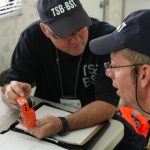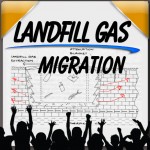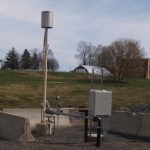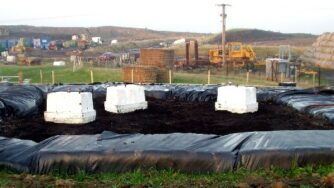Q: What is meant by the “explosive limits” for methane?
 A: Explosive Range and Flammability – A gas that will burn is said to be “flammable.” Any flammable gas can explode under certain conditions. The range within which an explosion can occur is known as the explosive limits for methane. In order for a flammable gas to explode, there must be enough of the gas in the air, enough oxygen, and a source of ignition.
A: Explosive Range and Flammability – A gas that will burn is said to be “flammable.” Any flammable gas can explode under certain conditions. The range within which an explosion can occur is known as the explosive limits for methane. In order for a flammable gas to explode, there must be enough of the gas in the air, enough oxygen, and a source of ignition.
The range of concentrations within which a gas will explode is also known as its “explosive range.” Figures representing the higher and lower limits of the explosive range are expressed in percentages are are referred to as the LEL, and UEL respectively.
The amount of oxygen that must be present for an explosion to occur is also expressed as a percentage. When the necessary oxygen concentration approaches that found in normal air, the level is expressed simply as “normal air.”
The explosive range of methane, for example, is 5 % to 15 % (by volume) in the presence of at least 12.1 percent oxygen.
The limits indicated are for gas and air at 20°C and atmospheric pressure.
Q: How is the Concept of “Avoiding Explosive Atmospheres” – Gas Mixtures within the Explosive (Flammable) Range Used to Keep Us Safe?
Controlling landfill gas concentrations outside the flammable limits is a major consideration in occupational safety and health.
Landfill Sites which produce methane, fall under Health and Safety Rules set up to avoid explosions. These safety rules are implemented in the UK under the EU ATEX Regulations, as implemented by the DSEA Regulations in England and Wales, alongside their counterpart regulations in Northern Ireland and Scotland.
Something which the public tend to become alarmed about when told about landfill gas emanating from landfills, is the idea that the whole landfill might explode. However, considering the upper and lower limits of flammability (explosion or fire) as above, it is clear that as long as the methane inside a landfill remains above the explosive limit there is zero risk of an explosion or deep seated fire. Of course, over extraction of landfill gas can draw-in air and create explosion risk. Much more prevalent is deep seated landfill fire developing if landfill gs extraction is excessive and not adequately controlled.
Monitoring Methane Concentrations
Methane can be monitored using a PID.
In these types of circumstances, PIDs (photoionization detectors) can provide an alternative, highly accurate, and poison-free means of measuring 10% of LEL for confined space entry.
What is a PID?
A Photo-Ionization Detector measures VOCs and other toxic gases in low concentrations from ppb (parts per billion) up to 10,000 ppm (parts per million or 1% by volume).
How does a PID Work?
A Photo Ionization Detector (PID) uses an Ultraviolet (UV) light source (Photo= light) to break down chemicals to positive and negative ions (Ionization) that can easily be counted with a Detector. Ionization occurs when a molecule absorbs the high energy UV light, which excites the molecule and results in the temporary loss of a negatively charged electron and the formation of positively charged ion.
The gas becomes electrically charged. In the Detector these charged particles produce a current that is then amplified and displayed on the meter as “ppm” (parts per million) or even in “ppb” (parts per billion).
The ions quickly recombine after the electrodes in the detector to “reform” their original molecule.
PIDs are non-destructive; they do not “burn” or permanently alter the sample gas, which allows them to be used for sample gathering. via wermac.org
Landfill Gas Monitoring Equipment
The choice of landfill gas monitoring equipment for modern landfills is wider than ever before. Types of Landfill Gas Monitoring Equipment Wikipedia provides a detailed explanation of the different types of landfill, gas monitoring, each of which demands it's own equipment to perform: Surface Monitoring For surface monitoring, a monitor may be either: Single reading […]
Testing Methods for Landfill Gas Migration Control
The investigation of the extent and source of landfill gas migration, is the first step in landfill gas migration control, and may need to take the path which follows: to identify the source of the gas; to identify the migration pathway; to understand the mechanisms causing the migration; This is essential for the engineers and technicians […]
Methane Flux Boxes for Monitoring Landfill Gas Cap Emissions
Methane flux boxes are a tool used to detect the flow (leakage) of landfill gas (methane) through landfill gas restoration capping layers. The UK Environment Agency may require that the landfill gas methane emissions from a landfill restoration cap are monitored regularly. This is required so that areas where excess gas might be escaping, can […]
Landfill Gas Flare Monitoring
Landfill Gas Flare Stack Monitoring Limitations Stack monitoring, or more correctly “landfill gas flare monitoring“, can only be carried out on enclosed flares. Enclosed flares are the only landfill gas flare type which can demonstrably provide a known minimum residence time and therefore are the only landfill gas flare type which is now accepted for […]








